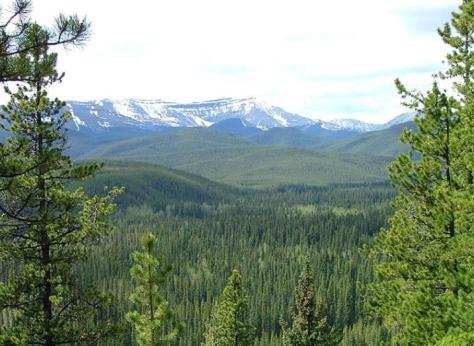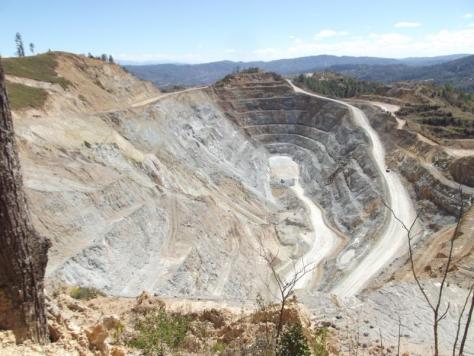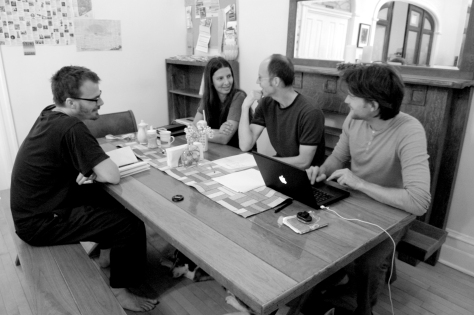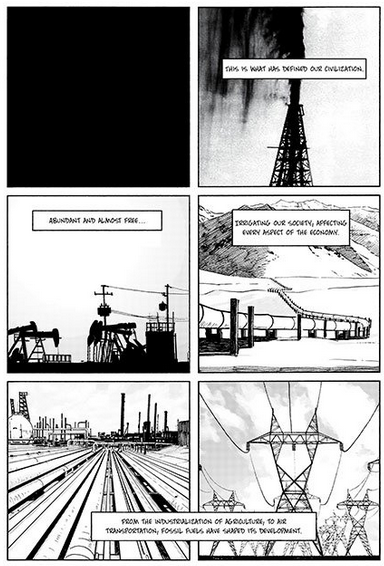As we’ve mentioned before, a number of the folks involved with
‘Extraction! Comix Reportage’ have gone on to do other important work. One of the most interesting and accomplished of the Extraction contributors (not that they aren’t all just fascinating) is journalist and activist Dawn Paley. We caught up with Dawn via phone call, since she’s currently living and working long term in Puebla, to find out what she’s been up to since the comic came out. Here’s how that went:
Ad Astra: Could you tell us a little bit about your history as an activist?
Dawn :I grew up in the lower mainland of British Columbia, on Coast Salish territory. I grew up in a pretty isolated area, this is pre-internet, so my first entry into activism was through environmentalism, eventually I started working as a journalist, doing media activism and grassroots journalism. Over the years, I’ve written about environmental and land issues ranging from the Canadian Boreal Forest Agreement to the impacts of US foreign policy and the expansion of capitalism on communities in Mexico, Central and South America.

I’ve been working as a journalist now for a little over 12 years, largely focused on Mexico, Central and South America, but especially Mexico. The piece I did for ‘EXTRACTION!’ [Gold: Taking the Heart of the Land] was the result of one of my first trips to Central America, and over the last decades I’ve continued to cover the ongoing dispossession, violence and colonialism taking place in Mexico, Central and South America. In my work I strive to explore the nature of the violences of capital and states, part of the work is to expose the connections between the global north and the violence that so deeply impacts so many folks in the global south.
Ad Astra: How did you first get involved in ‘EXTRACTION!’? How did you settle on the Goldcorp mine in Guatemala as the subject of the comic?
Dawn: I became involved with Extraction! because I had previously collaborated with [editor] Frederic Dubois, and later became friends with [editor] David Widgington of Cumulus Press as well. They asked me to do a chapter. They initially asked me to write about Barrick’s Pascua Lama mine in the high Andes in Chile and Argentina. I countered with a proposal to write about Guatemala/Goldcorp, suggesting that it would be a stronger piece because I’d already done interviews and research in the area. Plus, comics being a more visual thing it made sense to be working on a project about a place I’d seen first hand.

I knew the comic was going to be good as soon as I found out Joe Ollmann was working on the project. I immediately liked Joe’s style and his approach. We didn’t get to see a whole lot with each other – it was a long distance working relationship, but it was a nice experience. Joe has a fabulous sense of humor, and the final experience of seeing my words through Joe’s illustrations was incredible. It’s just totally different than print reporting.
Ad Astra: What was your collaborative process with Joe Ollmann like?
Dawn: It might be a bit passé for someone my age, but I confess, I’m a dyed in the wool print journalist. Obviously all journalism is teamwork, and sometimes I’ll work with a collaborator, like a photographer. Sometimes with print, you’ll write the piece and the photographer will send a cutline or two to go with their images, or your editor will suggest some changes to a piece. But with comics, the artist does so much work. Drawing, inking, and lettering takes so much time and skill. I don’t want to diminish what editors or photographers do…there’s a lot to it. But with this comic, it felt really different. It was an even longer process. It was interesting to have the surprise of seeing how he drew the things I saw and talked about, how he represented them. Workflow wise, we went back and forth long-distance, I compiled a script that included all kinds of visual clues I would leave out of a regular, reported piece, and went from there.

Extraction!’ artist Joe Ollmann meeting with Dawn, along with publisher and co-editor David Widgington and co-editor Frédéric Dubois. Photo by co-editor Marc Tessier.”
Ad Astra: Have you stayed in touch with Héctor and other people you met on the trip? What’s going on around the mine more recently?

Hmm. They’re pseudonyms in the story, so I needed to think about which person “Héctor” was. Yes, I’m still in touch with him. We G-chat sometimes. I saw him a couple of years ago when a serious earthquake hit the department of San Marcos; he took me around and brought me up to speed about what was happening in the region at that time. Goldcorp’s Marlin mine is in the process of closing, and they are doing a lot of public relations to make it look like they did a great job. I was in Guatemala in April and I saw a full page ad in the national newspaper, showing employees planting a bunch of trees in the area, you know, showing us that everything’s hunky-dory! But there’s a lot of ongoing health and environmental issues with contamination from the mine, and people are still facing charges for their role in resistance from years ago. I remember maybe five years ago, folks who survived the internal conflict pointed out to me how there were no basically no political prisoners in Guatemala until after the peace accords were signed in 1996. That was because the state didn’t take prisoners, rather it killed dissidents, activists, organizers, and entire Indigenous communities.
But today in Guatemala there is a HUGE amount of criminalization of community organizers. This criminalization specifically targets Indigenous communities and land defenders. People are thrown in jail, accused of huge list of charges, serving months and sometimes years for resisting dams, mines, highways, cement plants, palm oil, and so on. There are a lot of incredibly brave lawyers and activists fighting against the criminalization of land defenders and political prisoners in Guatemala, fighting for their release. I think this is really crucial context today that we need to keep in mind in looking at this comic from almost 10 years ago.
Ad Astra: Would you work on another comics journalism project, given the appropriate resources and journalistic freedom?
Dawn: I’d love to do another comics journalism project, connected to the research I’m doing with families of people who have been disappeared in Mexico. I’m doing a multi-year investigation into this issue as part of a dissertation, and what I hope will be my next book. When I can, I have been walking with family members on weekends, when they convene to look for bodies. It is a very intense experience–people using little more than sticks and shovels to search for missing daughters, sons, brothers, sisters… This is an entrenched reality in Mexico today and yet I think for many it is something that is still difficult to imagine. I think comics could be an important avenue to communicate this experience.
Ad Astra: How have things changed for mining activists since ‘EXTRACTION!’ was first released?
Dawn: Well, Indigenous land defenders across so called Canada have come out strong using a whole range of strategies to fight against destructive extractive industry projects throughout the entire last century and into this one. I think it is important to start by acknowledging the importance and the continuity of those struggles.
Specifically, EXTRACTION! first came out almost 10 years ago, and I think it’s still really relevant. As for differences between 2006 and 2016? There’s a lot more solidarity and visibility for these struggles, actually, including some really amazing organizing in Toronto and Vancouver. And urban activists are not just connecting the actions of Canadian companies in Guatemala or elsewhere with their headquarters in Toronto or Vancouver, but also looking at the activities of mining companies, sometimes even the same mining companies, on stolen Indigenous land in Canada. In my opinion, activism against destructive mining has gotten smarter, more intersectional.

We’ve seen huge amounts of community organization against mining happening, from the community level to the international level. In 2006-2007, I was reporting on a fairly nascent struggle in Guatemala… Now Goldcorp and gold mining has become a landmark issue in Guatemala. Folks all over the country know about it, they are prepared to fight against it and are pre-emptively declaring their communities free of mining… In general more and more folks and communities in Mexico, Central and South America are weary of Canadian or other mega-mining projects. People are mobilized against the damage that these companies are doing/can do to their water supply, their communities, and increasingly that organization is taking the form of international coalitions, groups that can represent hundreds of struggles. Over the past 10 years, many people resisting mining have been threatened, murdered, and displaced, but there have been huge strides around these issues in terms of awareness and preventative action, and it’s important we take note of the gains.
Ad Astra: What have you been up to since ‘EXTRACTION!’? What are you working on now?
Dawn: Well, I’ve continued to work as a journalist, in 2009 I helped found the Vancouer Media Co-op and was involved in various media projects in Canada for a few years. 2010 was a big year, we helped cover resistance to the Olympics in Vancouver and later to the G8-G20 in Toronto. At the year’s end I left Vancouver and started researching for my first book, Drug War Capitalism, which came out with AK Press in late 2014. Since the book came out I’ve been doing lots of speaking events in the US mostly, and we’re working to try and get a Spanish version of the book out soon. I also started a doctorate at the Autonomous University of Puebla in Central Mexico, where I am based.
At this very moment, I’m working on an investigative piece about families of the disappeared in Mexico, about the folks I mentioned who have started searching every every weekend for clandestine graves that may contain their family members. I’m writing about what it is like to walk alongside them as they search for their loved ones. I think that the movement of searchers is one of the most significant social movements in Mexico today, and one that urgently merits our attention.




 Seth Tobocman is a radical comic book artist who has been living in Manhattan’s Lower East Side since 1978. Tobocman is best known for his creation of the political comic book anthology World War 3 Illustrated, which he started in 1979 with fellow artist Peter Kuper. He has also been an influential propagandist for the squatting, anti-globalization, and anti-war movements in the United States. We’re very pleased to be working with Seth, and to share his experience and knowledge with Ad Astra readers. -NMB
Seth Tobocman is a radical comic book artist who has been living in Manhattan’s Lower East Side since 1978. Tobocman is best known for his creation of the political comic book anthology World War 3 Illustrated, which he started in 1979 with fellow artist Peter Kuper. He has also been an influential propagandist for the squatting, anti-globalization, and anti-war movements in the United States. We’re very pleased to be working with Seth, and to share his experience and knowledge with Ad Astra readers. -NMB 
 Title:
Title: 



